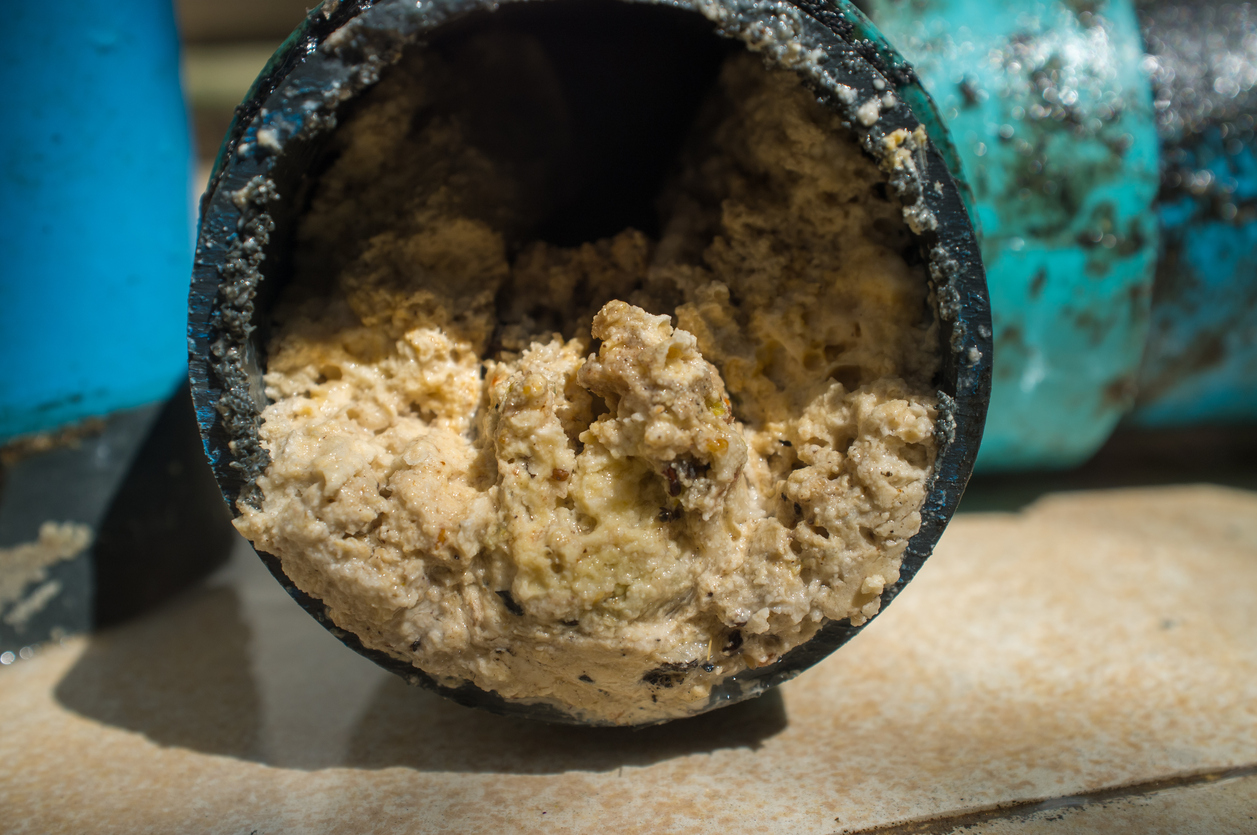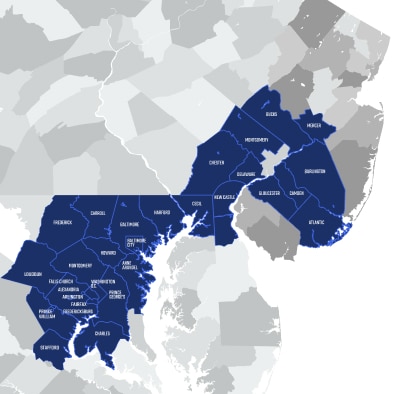Main Sewer Clogs: Causes, Warning Signs & Replacement Options
All of the plumbing fixtures, drains, and pipes in your home are connected to the biggest (and most important) piece of plumbing in your entire home is the main sewer line.
Between improper use of these fixtures, drains, and pipes and many other outside factors, the main sewer line can take a beating over time. Eventually, the main sewer line can become clogged (or even collapse) to the point of needing serious repair or even replacement. This wear-and-tear can turn into a headache that you don’t need!
Knowing what causes sewer lines to clog and the warning signs to look out for can help prevent you from ever having to deal with a major repair or replacement.
What Are the Common Causes of a Clogged Sewer Line?

Almost every homeowner has run into the unfortunate situation of having a clogged drain or a slow-running sink or bathtub. While a single clog can be a pain, it’s typically easy to fix.
However, what happens if all the drains in your home begin backing up at once?
It could be a sewer drain clog. The repair or replacement of an entire sewer line (or even just a section) is sometimes required when drain clearing efforts don’t work. Here are the primary indicators that a repair or replacement procedure is required:
Severe Pipe Damage
When sewer pipes are broken or ruptured, the sewage won’t be able to properly drain through the system—leading to immediate and frequent backups. Common causes of sewer pipe damage include:
- Sewer pipe rupture due to shifting soil, settling, increased traffic on the ground above, or use of heavy construction equipment above ground.
- Corrosion of an older pipe, causing the pipe to break or collapse.
- Leaking joints where the seals between sections of pipe have broken, allowing water and sewage to escape.
A Sagging Sewer Line
While this is out of a homeowner’s control, sagging sewer lines happen over time. This “bellied” pipe occurs when a section of the pipe has sunk due to ground or soil conditions.
The low spot in the line will begin to collect paper and waste—resulting in repeat blockages.
Tree Root Infiltration

Older sewer lines were sometimes constructed out of clay or other porous materials. In addition, the connections between the pipe sections weren’t as tight as today’s PVC pipes.
As tree and shrub roots grow, they search for sources of water. If they latch onto a sewer pipe, they will grow into the pipe in order to reach the water inside. As the roots expand over time, it can cause the line to break.
Flushing Debris Down the Toilet
For the sake of your plumbing system’s health, it’s important to know what you can and can’t flush down your toilet.
Treating your toilet as a trashcan will cause sewer drain issues. The number one rule to remember when flushing the toilet—make sure only human waste and toilet paper goes down.

Pouring Grease Down the Drain
Grease, fats, and oil are all some of the biggest culprits when it comes to clogging lines. It’s NEVER a good idea to pour grease, oil, or other fats down a drain.
Always pour hot grease into a coffee can or jar. Once it solidifies, you can throw it away. People mistakenly think that running hot water when pouring grease down a drain helps wash it away. This is not the case.
Once grease cools off, it will harden and stick to your pipes—leading to sewer line clogs. To make sure you never run into problems, educate yourself on things you shouldn’t put down your garbage disposal or drain.
The Top Symptoms of Sewer Line Issues
If you’re concerned about catching your sewer line issue before it’s too late, we’ve gathered four warning signs you should look out for:
Drains or Sewer Line Keeps Clogging
Our advice to you is to steer clear of liquid “drain cleaner” and call a professional to check out that backed-up drain! If you have a drain that continuously clogs, especially in the lowest level of your home, it could come from a break or blockage in your sewer pipe.
Multiple Fixtures Are Clogged
You aren’t sure if the toilet or shower drain keeps clogging because of an individual pipe blockage or because of a sewer line issue. However, a very obvious sign of a sewer line issue is when more than one plumbing fixture backs up at the same time.
Bubbling/Gurgling From the Toilets and Bathtubs
The next thing to look for when you suspect a sewer drain clog is any unexpected or unusual reactions when using plumbing fixtures. You may have a problem if:
- Flushing the toilet causes water to back up from your tub or shower.
- Toilet water starts to bubble. Should this happen, run water in the sink closest to the toilet for a minute or so. If the water continues to bubble (or rises), then it’s not a fluke.
- Hearing a gurgling noise as the toilet flushes or the water in your bathtub or shower is draining. If you hear this, contact your local plumber.
Your Lawn Starts to Change
A sewer line typically extends from your home, through your front lawn, and into the city’s sewage system. Head outside and see if you can notice any of these changes to your lawn:
- If you have a break in your sewer line, you’ll see an indentation on your lawn.
- If you find a soggy patch of grass when it hasn’t rained or snowed recently, it may be sewage from a broken sewer pipe.
What Are The Sewer Line Repair & Replacement Options?
While some drain cleaning and maintenance tasks can be safely performed by a homeowner, sewer line repair and replacement tasks should always be performed by a certified, professional plumber.
Video Inspection
By employing an in-line video inspection camera, you will be able to see where the problem lies and experience faster and less costly repairs. Here’s how it works:
- Images captured by the camera are transmitted to a device operated by the camera technician. These images are recorded for further review.
- At the same time, a radio transmitter on the camera records the physical location of the line and its depth from the surface, so the appropriate repairs can be properly planned and implemented.
Once it’s determined—and you agree—that a sewer line must be repaired or replaced, there are a few options to choose from.
Traditional Sewer Line Repair or Replacement
The traditional sewer line repair or replacement is typically performed using a backhoe to dig up the area surrounding the line, allowing easy access to the problem area. Once the repair is made, the backhoe is used to refill the area.
This option may be the only option at times, depending on the condition of your pipes, their configuration, or where you live.
Trenchless Sewer Line Repair Methods
Trenchless repairs involve making small access holes where the damaged pipe starts and ends. A new pipe is then pulled through the existing pipe, which bursts the old pipe into pieces while simultaneously laying new pipe.
Trenchless repairs cause less damage to yards and driveways than traditional repair methods because only the dirt at the beginning and end of the line is disturbed.
Contact a Professional Plumber for Your Sewer Line Repair Needs
No matter what option you eventually choose, the work needs to be completed by an experienced and licensed professional plumber. At Len The Plumber Heating & Air, we’ve been serving the Mid-Atlantic region with unrivaled plumbing services for more than 20 years, and we consider our plumbers the best in the business. If you’re having a sewer or drain issue, we guarantee we can diagnose and fix it—often the same day!
For sewer line repair and replacement in MD, DC, VA, DE, or PA, trust the experts at Len The Plumber Heating & Air. Contact us online or call (800) 950-4619 today!
From Len The Plumber Heating & Air
 Coupons
Coupons 

